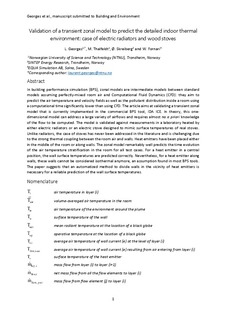| dc.contributor.author | Georges, Laurent | |
| dc.contributor.author | Thalfeldt, Martin | |
| dc.contributor.author | Skreiberg, Øyvind | |
| dc.contributor.author | Fornari, Walter | |
| dc.date.accessioned | 2019-04-02T07:26:13Z | |
| dc.date.available | 2019-04-02T07:26:13Z | |
| dc.date.created | 2018-12-10T09:23:49Z | |
| dc.date.issued | 2019 | |
| dc.identifier.citation | Building and Environment. 2019, 149 169-181. | nb_NO |
| dc.identifier.issn | 0360-1323 | |
| dc.identifier.uri | http://hdl.handle.net/11250/2592819 | |
| dc.description.abstract | In building performance simulation (BPS), zonal models are intermediate models between standard models assuming perfectly-mixed room air and Computational Fluid Dynamics (CFD): they aim to predict the air temperature and velocity fields as well as the pollutant distribution inside a room using a computational time significantly lower than using CFD. The article aims at validating a transient zonal model that is currently implemented in the commercial BPS tool, IDA ICE. In theory, this one-dimensional model can address a large variety of airflows and requires almost no a priori knowledge of the flow to be computed. The model is validated against measurements in a laboratory heated by either electric radiators or an electric stove designed to mimic surface temperatures of real stoves. Unlike radiators, the case of stoves has never been addressed in the literature and is challenging due to the strong thermal coupling between the room air and walls. Heat emitters have been placed either in the middle of the room or along walls. The zonal model remarkably well predicts the time evolution of the air temperature stratification in the room for all test cases. For a heat emitter in a central position, the wall surface temperatures are predicted correctly. Nevertheless, for a heat emitter along walls, these walls cannot be considered isothermal anymore, an assumption found in most BPS tools. The paper suggests that an automatized method to divide walls in the vicinity of heat emitters is necessary for a reliable prediction of the wall surface temperatures. | nb_NO |
| dc.language.iso | eng | nb_NO |
| dc.publisher | Elsevier | nb_NO |
| dc.rights | Attribution-NonCommercial-NoDerivatives 4.0 Internasjonal | * |
| dc.rights.uri | http://creativecommons.org/licenses/by-nc-nd/4.0/deed.no | * |
| dc.title | Validation of a transient zonal model to predict the detailed indoor thermal environment: case of electric radiators and wood stoves | nb_NO |
| dc.type | Journal article | nb_NO |
| dc.type | Peer reviewed | nb_NO |
| dc.description.version | acceptedVersion | nb_NO |
| dc.source.pagenumber | 169-181 | nb_NO |
| dc.source.volume | 149 | nb_NO |
| dc.source.journal | Building and Environment | nb_NO |
| dc.identifier.doi | 10.1016/j.buildenv.2018.12.020 | |
| dc.identifier.cristin | 1640898 | |
| dc.relation.project | Norges forskningsråd: 243752 | nb_NO |
| dc.description.localcode | © 2018. This is the authors’ accepted and refereed manuscript to the article. Locked until 10.12.2020 due to copyright restrictions. This manuscript version is made available under the CC-BY-NC-ND 4.0 license http://creativecommons.org/licenses/by-nc-nd/4.0/ | nb_NO |
| cristin.unitcode | 194,64,25,0 | |
| cristin.unitname | Institutt for energi- og prosessteknikk | |
| cristin.ispublished | true | |
| cristin.fulltext | preprint | |
| cristin.qualitycode | 2 | |

